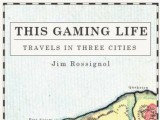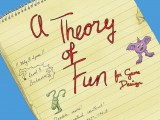Contents
- 1 Is This Games Journalism, NGJ, or Critique?
- 2 The Question of Journalism
- 3 So, About That S#%t You Mentioned?
- 4 Difference
- 5 Authorial Intention
- 6 Interpretation and Video Games
- 7 On the Meaning of S#%t
- 8 S#%t
- 9 Wilful Semantic Ignorance
- 10 Fandom, Fetishism and Ludology
- 11 Just a Function
- 12 Ludonarrative Dissonance
- 13 The Dictators of Meaning

I had (erroneously) assumed that I would never, ever be writing about s#$t in video games, but after recently posting my conceptual/generic analysis of The Binding of Isaac, questions of merit, value/quality and meaning, as well as the overall relevance of video game criticism, emerged - chiefly at Rock, Paper Shotgun, as usual, the Mecca of Video Games that it so happens to be (props to the poster Hexagonalbolts for the tip).
A swift return to the wonderful, wonderful world of Isaac is thusly in order. Obviously, being the hotbed for argument that it inherently is thanks to its religious leanings, The Binding of Isaac has been more or less at the centre of critical attention ever since its release.
Still, the mere idea of taking Isaac, well, seriously, seemed to produce in some commenters a more intensified response yet, and indeed, many questions were asked, more arguments had, with many an opinion ranging from the honest to the ironic. The question seemed to be, isn’t it simply too much to write about Isaac like this? Here are a series of strawmen of some of the aforementioned:
- Are video games worthy of or suitable for analysis?
- Is The Binding of Isaac worthy of such a critique?
- Shouldn’t video game criticism be just about play and/or quality?
- Are any of these meanings intended? Why look for them if they aren’t?
- Why bother?
I’m not so sure that I can come even close to answering these questions in just one article, but on the whole, the question of “Why bother?” seems to encompass the rest of them. We’ll stick to that, for the most part. The reason I’m quick to jump into the fray with an in-depth response is that I find this particular discussion, of meaning, to be relevant for video game criticism on the one hand, and separate from the “games as art(?)” discourse on the other, even if this doesn’t appear to be the case first-hand.
The one chief aim of this article, then, is to answer the question of “Why bother?” especially as it pertains to the semantic/narrative functions of video games, as well as to discuss our understanding of video game criticism (its aims, objects, uses). As mentioned, I will rather try work my way around the question of “art”, only ever dipping my toes in its waters with the intention of otherwise staying firmly ashore.This discussion revolves around the presence of meaning in video games - on how it is formed, accessed, received and analysed. The reason I’m talking about The Binding of Isaac once again is simply to kill two birds with one stone and illustrate how the game might be relevant to our interests. As a final note, I am in the process of compiling a page of definitions that should hopefully open some of the terminology present in this post, should anyone find this particular aspect of the post lacking. Thanks for your interest!
Is This Games Journalism, NGJ, or Critique?
Nope. Some observers were keen to point out that perhaps this discussion (of merit, relevance, value/quality and meaning) relates to what comic author and ex-Rock, Paper Shotgun games writer Kieron Gillen originally and famously characterized as New Games Journalism (or NGJ for short) in 2004.
This is not the case. Simply put, NGJ (as I understand it) is experientiality-based journalistic reportage of (game)play that engages the reader via contextual embellishment and the use of first-person narratives in an attempt to convey the experience of playing. Quoth Gillen,
What a gamer feels and thinks as this alien construct takes over all their sensory inputs is what’s interesting here, not just the mechanics of how it got there. Games have always been digital hallucinogens – but games journalism has been like chemistry, discussing the binding reactions to brain sites.1
The manifesto famously stated that:
[The games journalist’s] job is to describe what it’s like to visit a place that doesn’t exist outside of the gamer’s head – the gamer, not the game, remember. Go to a place, report on its cultures, foibles, distractions and bring it back to entertain your readers.1

Jim Rossignol’s (also of RPS) book, This Gaming Life (2008, available in full online), is at least to me very much NGJ exemplified. The same can be said of Tom Bissell’s book Extra Lives (2010). Among other things, these writers delve in the realms of experientiality, opening doors and windows to particular boxes, rooms, houses and worlds of gaming.
(What Rock, Paper, Shotgun do overall, however, is pretty much write whatever they want in a way that interests the authors as much as their readers. They have a knack for that, but I’m not so sure that it’s too NGJ most of the time. No matter, some people thought NGJ was $%#t as early as it first emerged.)
Either way, as a games writer, you can hardly go wrong with Rossignol’s modus operandi:
[Games]’ve changed people’s lives, and my motivation is as simple as that: they changed my life and I’ve been writing about that for years. Games have provided much of the cultural backdrop to our lives, and have the same emotional resonance as movies, novels, or music for the people who play them.2
The Question of Journalism
You can probably already see a clear-cut difference in approach emerging; where an application of NGJ would more interested in conveying the experience of playing, we are more focused on how the functions and effects of the experience of playing are formed in the first place.
As for definitions of the aforementioned - journalism, critique and criticism - I believe that insofar as contextually relevant opinions and objects of interest are reported, that is journalism. If opinion is present, that is probably critique. Finally, if emphasis is placed upon the (in)validation of that opinion, then, that might as well be criticism.
In terms of video games, journalism and critique are conventionally pretty much the same thing, and also something that we too do in our reviews here. That being said, I can’t not mention that a whole discussion of the nature video game criticism already exists, with for instance Mr. Dan Cook claiming that what the world needs is more “game analysis”, suspecting it is “too late for the field of game criticism to ever again broadly mean ‘critical thoughts about games'”3, to which Ben Abraham responded in kind, wondering whether Cook should “reconsider whether he’s actually interested in ‘criticism’ or not; as a practice more like art, and one that does not depend on a utilitarian purpose.”4
Critical, schmitical, blah blah blah! In other words, a conversation exists for those willing to participate. I understand that allegiances and definitions are important, but for the time being, let us talk about meaning, the primary object of study in criticism.
So, About That S#%t You Mentioned?

Discomfort is sometimes an indication of your psychological defense mechanisms flaring up. I think most of us are/were somewhat uncomfortable with The Binding of Isaac, so why not go all in. Or knee-deep, as they say, at the very least. In this case, then, we must posit the question: What are the functions and effects that make the game an uncomfortable experience?
If there’s one thing that most of us can probably agree on, is that The Binding of Isaac does some things very differently, even if you perceive the game as a coiled-up bunch of derivative, unoriginal, blasphemous angries. I can’t and won’t deny the existence of such a convention; it just so happens that this convention is not one that is prevalent on Valve’s Steam platform.
It’s different. Take its representation of and reference to the external world, and compare it to previous games of the same style: Again, Zelda’s visualization and world-building is based on a much more conventional system of verisimilitude, influenced by and in essence an attempt of modeling Shigeru Miyamoto’s experiences as a child. It looks and sounds like the “real” world of games. We know this because Miyamoto himself often repeats this as fact:
Miyamoto has told variations on the cave story a few times over the years, in order to emphasize the extent to which he was surrounded by nature, as a child, and also to claim his youthful explorations as a source of his aptitude and enthusiasm for inventing and designing video games.5

Isaac, then, is a psychedelic versioning of Miyamoto’s whimsical interpretation of the Japanese environs. That simultaneously makes the game also very much more of the same, something that makes the game so interesting.
The Binding of Isaac deviates from the standard on the two facets of the game: the semantic and the ludic. On the former level, the game is a parody, a carnivalesque of Zelda (I am error!) - in its genre, style, substance and content, and use of symbols (For the brevity of this argument, let’s not even go into its position as a perverted parable from the Bible) among other aspects.
On the latter level, then, in its gameplay, the game borders on pastiche and even direct reapproppriation in its Zelda-ness. Pastiche, as much as parody, is a form of critique, for it cannot exist but in relation to the object of pastiche. This is something to consider in a different story, though; instead, let me briefly discuss the question of difference on a more rudimentary level yet.
Difference
So far, we have only really established that The Binding of Isaac is both different and more of the same at the same time. How is this relevant in the context of the overarching argument, which is, to say, “Why bother?”
From a critic’s point of view, The Binding of Isaac is a ridiculously exemplary object of critique, given its moderate scale, semi-indie, auteur-like metatextual qualities, distinct audiovisual style, and exceptional correlation with other works of art (cough!). Due to its relative closeness to other games as pastiche and parody, The Binding of Isaac is extremely representative of the ludic/semantic dichotomy in video games; of the relationship of gameplay to audiovisuals, of rules to narrative exposition. It simply demands to be discussed as an example.
As you know, meaning is not engendered without reference. Modern semiotics (or semiology, whichever is your cup of tea) still relies, to a degree, on Ferdinand de Saussure’s assumption that meaning is based on difference. Language, to de Saussure, was (among many other things) “a series of differences of sound combined with a series of differences of ideas”6

This may sound needlessly complex at first, but consider this: Before de Saussure and his peers, human beings didn’t really think (or talk, rather!) of meaning the same way they do today. It’s an incredible proposition: Modern linguistics is barely a hundred years old. Video games emerged, in many ways, at the single most opportune moment for us to discuss them, to analyse them. We must seize the moment and use these beautiful tools of interpretation. Your parents did not have them. Our current conception of pastiche, for instance, is literally all-new.
One can point at the technical advancements of the 1960s and 1970s, but from my multimedial perspective, video games emerged in succession (as well as in conjunction) to other forms of art such as modernism, postmodernism and pop art. All this talk about observers lacking the competency to analyse video games? This couldn’t be further from the truth. A hundred years ago, we didn’t have the linguistic tools to discuss MEANING or LANGUAGE, let alone GAMES, the way we do today.
For that, we should thank de Saussure, Chomsky, Foucault, Pierce, et cetera slowly dripping downwards into curricula. This is, again, something to consider - as is video games’ status as a “young medium”. (I should think that classifying video games as an “old medium” is like classifying radio or television, or the LP as an “old medium”. From my point of view, neither is true. This does not mean, however, that we lack the competency to appropriately deal with them, which is what the aforementioned article rails against, as well).
(Any moment now, someone will creep out of the woodwork and say, “But different doesn’t mean good”.)
Authorial Intention
 Right. It really doesn’t. In a more contextual sense - rather than theoretically - “difference” actually has a bad, bad rap, given the apparent hegemony of certain concepts to others (occident to orient, white to black, right to left, light to dark, and so forth). As much an aside as it is for the sake of the overall argument, it has indeed been established that The Binding of Isaac is a pretty good game. Metacritic shows the game with a critic average of 84. Another proof of the game’s successes is that McMillen & Himsl are in fact shortly to come out with a DLC package called Wrath of the Lamb.
Right. It really doesn’t. In a more contextual sense - rather than theoretically - “difference” actually has a bad, bad rap, given the apparent hegemony of certain concepts to others (occident to orient, white to black, right to left, light to dark, and so forth). As much an aside as it is for the sake of the overall argument, it has indeed been established that The Binding of Isaac is a pretty good game. Metacritic shows the game with a critic average of 84. Another proof of the game’s successes is that McMillen & Himsl are in fact shortly to come out with a DLC package called Wrath of the Lamb.
But even then, not everyone is convinced; there must be some sort of observable, tangible quality present, hidden within the game, that warrants our attention. Could “effort”, “time” and “vision” alone be worthy of our critical respect? After all, McMillen’s Isaac devblog (“for gay nerds”) reveals to us that something was indeed done. Destructoid’s Jordan Devore called, in his review, The Binding of Isaac a “A deceptively deep game”7. Devore, though, doesn’t actually mean what you think he means based on the context of the citation. He’s actually talking about the ludic richness of the game.
This relates to my point. The question of “depth” relates to a historical mode of criticism, one that has yet to leave us and quite possibly never will, which is the question of authorial intention, which is the attempt to discover - or rather, recover - the hidden meaning(s) of a particular work via the use of biographism - association, contextualization and background research. This mode, I think, is what most of us consider to be the default mode of “criticism”.
Which, then, leads us to ask the question, “What led Mr. Edmund McMillen to subvert the established convention of shrubbery with piles of s#&t? (In conjunction with a hidden hypothesis: Surely it was his upbringing! Surely his childhood! Surely Freud!)”
We have now entered the realms of McMillen and Hinsl’s artistic integrity. Let me throw out some more potential theses: Perhaps Mr. McMillen is a perverted sort of chap - a coprophiliac? Surely we must entertain this possibility in relation to his game? Looking at McMillen’s back catalogue, which includes games such as Cunt and Time Fcuk, it’s apparent that we can conceptualize and sketch out an image of Mr. McMillen’s persona: Clearly, this is a prepubescent, at the very least an adolescent persona. It all meshes and gels.
(In case you didn’t notice, I’m joking. We don’t have a designated font for irony here. I’m not assaulting McMillen’s character, but rather illustrating the style and mode of criticism.)
Interpretation and Video Games
Consider Wolfgang Iser’s view, already from 1976, that it seemed as though art itself had begun to “react against the traditional form of interpretation”8. Here, Iser was referring to the emergence of postmodernism (and/or metafiction) and postmodern art, but might just as well have been talking about video games, which are inherently bound to question their own meanings in practice due to their form.
Video games, by default, have a tendency to resisting interpretation that seeks to point out an intention or a hidden meaning; not only are video games an extremely co-operative form of creativity and produce, but additionally, just think of the modern shooter: The good guy is a really, really bad guy. Killing is actually scoring points.
As I attempted to illustrate in my article on The Binding of Isaac, this is simply the practical result of the form: Ludic function conflating and flattening together with the semantic. Consider Michael Abbott’s (of Brainy Gamer) poetic way of describing this idea:
I believe video games naturally facilitate collisions between what a player does or thinks; what is represented or enacted on screen; and what all of this means.9
This awful mockery of biographism above simply exists simply to illustrate the inherent problems relating the questions of “quality” or “intent” (collective, artistic or otherwise - or more importantly, lack thereof) to a video game. The “games as art” discussion, especially, goes off the tracks in being so very bothered with questions of authorship or intent, when it should rather be invested in the collisions, the gaps, the relationships, the contexts that engender meaning. In killing as equivalent to scoring points.
On the Meaning of S#%t

To your great great disappointment, I’m sure, I promised to talk about $h¤t and yet have largely failed to do so. This, then, is my present to you. I shall very quickly attempt to illustrate how the ludic functions of s#&t in The Binding of Isaac tie in with the semantic. None of this is to be taken seriously, of course, but rather as a model for analysis.
Human faeces carries with it many connotations: Of taboo and humour (taboos stemming from humour, and humour stemming from taboos). It carries with it a sense of social and societal rule. Convention. Control. Culture. Hegemony. Growth. Development. Banality. Necessity. Deprived of these, it carries with it a connotation of sickness, illness, inhumanity, barbarism, even bestiality.
It also activates connotations of childhood. At once, it activates within us a feeling of secrecy, of forbiddenness, of relief. In terms of visual or auditory response, we find ourselves to be disgusted, repulsed - or at the very least slightly annoyed by its presence.
Even in taking just a few of these meanings into account, playing The Binding of Isaac becomes at the very least a more private enterprise. It makes our response to the more inhumane thematic aspects of the game vastly more personal. It bothers us, teases us, annoys us with its many meanings.
(Questions of response would be better served in an NGJ-oriented article, however.)
Consider this: As far as this one sprite, the turd - this spiral-shaped, hilarious-looking comedic bottle of joy - The Binding of Isaac and Zelda are joined at once into a metonymical (a part of a whole, metaphorical or concrete) relationship. Consider manure together with plants. The former helps the latter grow, as fertilizer. That Zelda and Isaac are already engaged in critical interplay, via the latter’s use of parody and pastiche, only makes this relationship all the more intriguing.
Additionally: What can be found on the floor/on the ground, can be stepped into/onto, hacked into pieces, and can house items, but is not a barrel or a box?
Well, sh%#t.
S#%t
Sh%#. It’s surprising to discover how well it actually fits into the established ludic conventions of the Roguelike, or in fact, into conventions established by wildly different generic conventions, like breaking boxes in first-person shooters like Half-Life, cutting bushes in Zelda, head-butting or stomping on tiles in Mario, and so forth. Most players will instinctively chop away at any of the aforementioned in any new game. Even if they don’t, at first, they will eventually come to think of the aforementioned objects as sources of rewards.
Even in its parodic form, The Binding of Isaac’s piles of excrement make almost as much sense as Link finding an endless stream of Rupees in the shrubbery. But do consider the literal implications of the idea of the turd as a ludic reward - or that they can sometimes be used as defensive cover (like in the case of Larry Jr.). No matter what McMillen actually sought to achieve with his sprite switcheroo, he’s definitely managed to create a, uh, a real mess of meanings.
To conclude, we must ask ourselves - what are the effects of deviating from the standard? What are the meanings that emerge from not retaining a more conventional representation of the shrubbery - or barrels, or boxes? After all, to better fit the thematics of the genre, to adhere to a more standard form of verisimilitude, it could have been… urns of ashes, or piles of whitened bones.
To the ludologist, the representation of this particular item seems, by default, to be an extraneous question of player feedback. To us, difference alone renders it significant that we are in fact dealing with a pile of s#%t.
Wilful Semantic Ignorance
Let’s once more consider Iser’s view of texts initiating “‘performances’ of meaning rather than actually formulating meanings themselves”10. Consider this rather in conjunction with the video game. The ludic (programmatic, rule-based) coined with the semantic (meaning-related, representative) aspects in video games together invite the player to act as agent within the game’s diegesis, its game world, which functions in accord with the rule systems as devised (but again, not always as intended) by the developers.
For example, players of The Binding of Isaac are not only invited and dragged into to the narrative context or “situation” of Isaac, but also, perhaps even chiefly, to learn and even master the game’s controls, figure out the enemies’ patterns of movement and attack, learn the management of the game’s multiplicitous items, and for some players with more experience, to mirror their experiences against the conventions of the Roguelike. And so forth.
To borrow from Iser, playing is performing is learning is creating meaning according to the rules of the game as defined by their author(s). Consider this: As much as we’re invited to perform as agents and subjects in the ludic component of the game, to grok (Koster) it, why should we not also be invited as “players” and “subjects” to the semantic component? If it’s perfectly okay to discuss the “various possible effects”11 of the ludic component - again, the various aspects of the gameplay - why should it be wrong, then, to ask what we can make of the semantic component, and furthermore, what are the meanings that emerge in the collisions of the ludic to semantic?
My overarching thesis is this: The ludic and the semantic both need to be considered observable functions of the game. Both components are equally systemic, structural and contextual, and both are equally functions and effects of the particular game. (Note: If someone *cough* argues that narrative is not a mechanic, either they are misguided, have an agenda, or their conception of either gameplay or narrative is funky. But that is a discussion for another time.)
Fandom, Fetishism and Ludology
I often wonder if the negative sort of response to criticism or analysis of popular media products is more broadly related to the existence of fandom, and not just a specific tendency of the video gaming community. Fandom is indeed a curious thing: Some of us are very much into books, video games, movies, comics.
Fetishism is the ultimate form of objectification, wherein the meaning of the fetish is supplanted by the fetishist’s feeling for this item. Once something becomes a fetish, then, looking below the surface seems to the fetishist largely an attempt to ruin their fun and enjoyment. Why would a fetishist want to know what the fetish represents, means, or what its functions are?

A pronouncedly ludological approach to game theory often equally reminds me of, well, fetishism. Despite claims to the contrary, to many players, the programmatic nature of video games is in fact clear-cut and requires no greater explanation. Especially to competitive players of shooters or MMOs, the process of understanding the rules of a game, or grokking, is key to the enjoyment and, ultimately, mastery of the game.
In this manner, the ludic functions of the various objects and items in the game often completely supplant their semantic meanings over time: All that remains, in the player’s view, is the object’s function in the game’s rules: Shooting a gun in the game world becomes but a form of scoring points - and ultimately winning. All games tend to reveal their gameness through what some commentators call ludonarrative dissonance (or harmony, if the ludic and semantic components are seen to be appropriately congruent).
From this angle, it seems the ludologist is right: Whatever elaborately painted, represented and framed win/lose scenario ultimately seems to be reducible (or reduces) to 0s and 1s. Someone wins, someone loses.
Just a Function
Bits of code and art in video games both often have their basis in someone’s experiences, like Miyamoto’s in Zelda. McMillen himself claims that The Binding of Isaac was based on his experiences of Catholicism, as outrageous as that may sound:
The majority of what I’m drawing on is my experience with Catholicism, the pros and cons, I guess. It [is] honestly me having a conversation with myself about how I felt about religion growing up, and that’s how it came out.12

Whether they like it or not, even the most solitary of programmers write code in the real world on the basis of their personal experience - both in the sense of learning how to code, but also as learning to code as members of society. This is also why games most often masquerade in well-known genres of fiction that naturally support the ludic component. This is the reason why we “play” war. This is also the reason why so many old board games are actually simulations of either war or, more broadly, conflict. When Trevor Owens explains, in relation to the game Colonialization, how
…we could say that we can see the colonialism of the game represented in the colonialism of the code. With that said, it is clear that this is a relatively efficient way to write code for the game’s peoples. The Natives are not the result of special creation. In effect, the scripts speak them into existence at the level of code as a defunct, stripped, and inhibited version of their oppressors13.
You may laugh at the slight awkwardness of the object of his study, but if anywhere, this is where the conception of “nativity” as semantic meaning collides with the ludic. As long as video games represent something, anything, verisimilitude is introduced, and the game’s models, textures, architecture, genre and topos will always and forever affect the player’s perception and interpretation of the game’s world.
Ludonarrative Dissonance

In my article, I have sought to illustrate how the player’s position as a learning, performing agent in video games begs us to also consider the manner in which the ludic components of video games collide with the semantic.
Clint Hocking’s “Ludonarrative Dissonance in Bioshock“, wherein he introduces the conception of ludonarrative dissonance in illustrating how BioShock 1‘s player/game contracts, attempts to explain how the game’s ludic and narrative facets seem to be on an interpretative collision course and thus take players “out” of the game’s fiction, making suspension of disbelief harder if not impossible. Even more telling is Hocking’s disappointment with this “dissonance”:
To mock us for accepting the weaknesses of the medium not only insults the player, but it’s really kind of ‘out of bounds’ (except as comedy or as a meta element – of which it appears to be neither).14
Here, I have rather sought to portray games more as sums, networks and bunches of colliding meanings rather than wholes of coherent intention, like Hocking’s analysis would seem to imply. In his response to Hocking’s classic piece, Michael Abbott actually acutely posed the following question:
Does the road to ludonarrative unity really lead us where we want to go? Is the destination reachable? Is it possible to embrace a design aesthetic that takes us in another direction that could be just as fruitful, if not more so?9
Here, Abbott is probably referring to the video game’s potential as simulation, of something so hyperreal that you can no longer “tell” the game from reality. But even if this were to be the case one day, meanings are never going to be fully congruent with each other. Will emergent ideology, sexism, racism or bigotry take you out of the “game”? Is that also meant, intended, or part of the immersion?
If it’s inherently natural for games to carry these collisions between the ludic and the semantic, inherently producing interpretative dissonance, then, it seems to me only natural for criticism to leave the notions and conceptions of immersion, or suspension of disbelief to, say, New Games Journalism (no disrespect meant) and instead focus on these emergent collisions of meanings. Like Abbott says, “…sometimes the mechanics are just as interesting as the story itself.”9
The Dictators of Meaning

The sole reason I have sought to avoid both the “games as art” discourse as well as the “narrative as mechanic” discussion so far is because neither seem to have been very invested in the above question of meaning. This article has been my heartfelt attempt at illustrating why video games criticism should care also for the semantic component of a video game, for our conception of and our relationship with meaning has profound effects on the ways in which we discuss “art”, “narrative” and “gameplay” in turn.
Even with the advent and subsequent twilight of existentialism, for instance, meaning(lessness) is still very often handled poorly by human beings. It’s as if we were inherently programmed to hunger and desire for coherence, even where it does not exist. That such a dislike of uncertainty, introduced by the multiplicity and duplicity of meaning, should lead to an unwillingness to look at video gaming’s interpretative possibilities as the sum of a conventional (or non-conventional), generic structures, effects and functions, is a fully understandable one.
That a meaning should exist within the game not as a coherent, harmonic givens, but a function to be performed, construed, and even analysed, can be a puzzling, even angering proposition. Collisions of meaning (insta-killing Mother with The Bible in The Binding of Isaac) occur, and will occur in the future, as long as games bear any resemblance to reality, really. Furthermore, games make this question all the more difficult, for there exists almost the requirement to turn a blind eye to these collisions of meaning; after all, the various semantic meanings of a video game can be a source of distraction to players trying to grok the ludic facet of the game.
Ultimately, however, reacting negatively to the actual question of meaning is to me a sign of immaturity and wilful ignorance. In choosing explicitly not to entertain the potential emergent meaning(s) of video games, the commentators - players, journalists, developers, critics and researchers alike - are nipping a constructive discussion in the bud.
“But The Binding of Isaac is s#%t.”
But you know, s%#t is a function and has meaning to it. Let’s look at it!
- http://gillen.cream.org/wordpress_html/?page_id=3 [↩] [↩]
- http://www.press.umich.edu/pdf/rossignol_11635.pdf [↩]
- http://www.lostgarden.com/2011/05/blunt-critique-of-game-criticism.html [↩]
- http://iam.benabraham.net/2011/05/a-response-to-dan-cooks-blunt-critique-of-game-criticism/ [↩]
- http://www.newyorker.com/reporting/2010/12/20/101220fa_fact_paumgarten?currentPage=all [↩]
- de Saussure, Ferdinand 1959: Course in General Linguistics. New York: New York Philosophical Library. pp. 121–22. [↩]
- http://www.destructoid.com/review-the-binding-of-isaac-212806.phtml [↩]
- Iser, Wolfgang 1978/1976: The Act of Reading. A Theory of Aesthetic Response, 11 [↩]
- http://www.brainygamer.com/the_brainy_gamer/2008/12/dissonance.html [↩] [↩] [↩]
- Iser 1978, 27 [↩]
- Iser 1978, 18 [↩]
- Interview: Edmund McMillen Spills The Beans on The Wrath Of The Lamb & More [↩]
- http://www.playthepast.org/?p=2509 [↩]
- http://clicknothing.typepad.com/click_nothing/2007/10/ludonarrative-d.html [↩]
Your original piece was so strong. The fact that we still have to answer these questions about “are games worthy of analysis” is just depressing. I have been thinking about writing a follow-up to your article and talking about how some Kristevan themes are continued all the way into the procedural layer of Binding.
I hope I don’t have to tell you to send a link to your analysis as soon as it’s out! If you have Twitter, for instance, hook me up!
Yeah, as soon as it’s done!
-Alexei